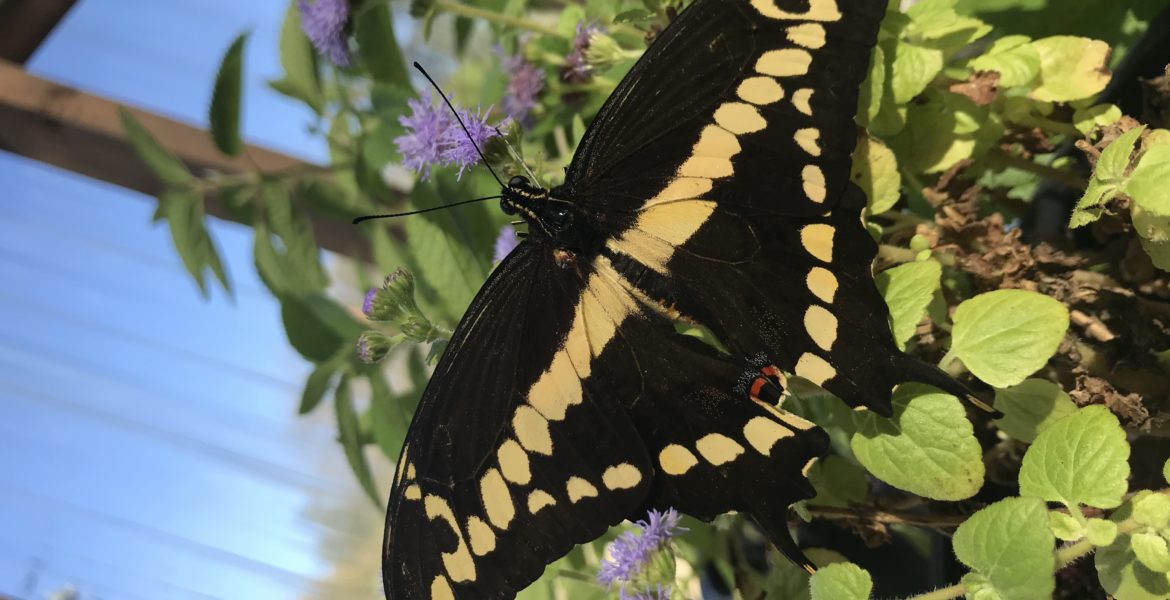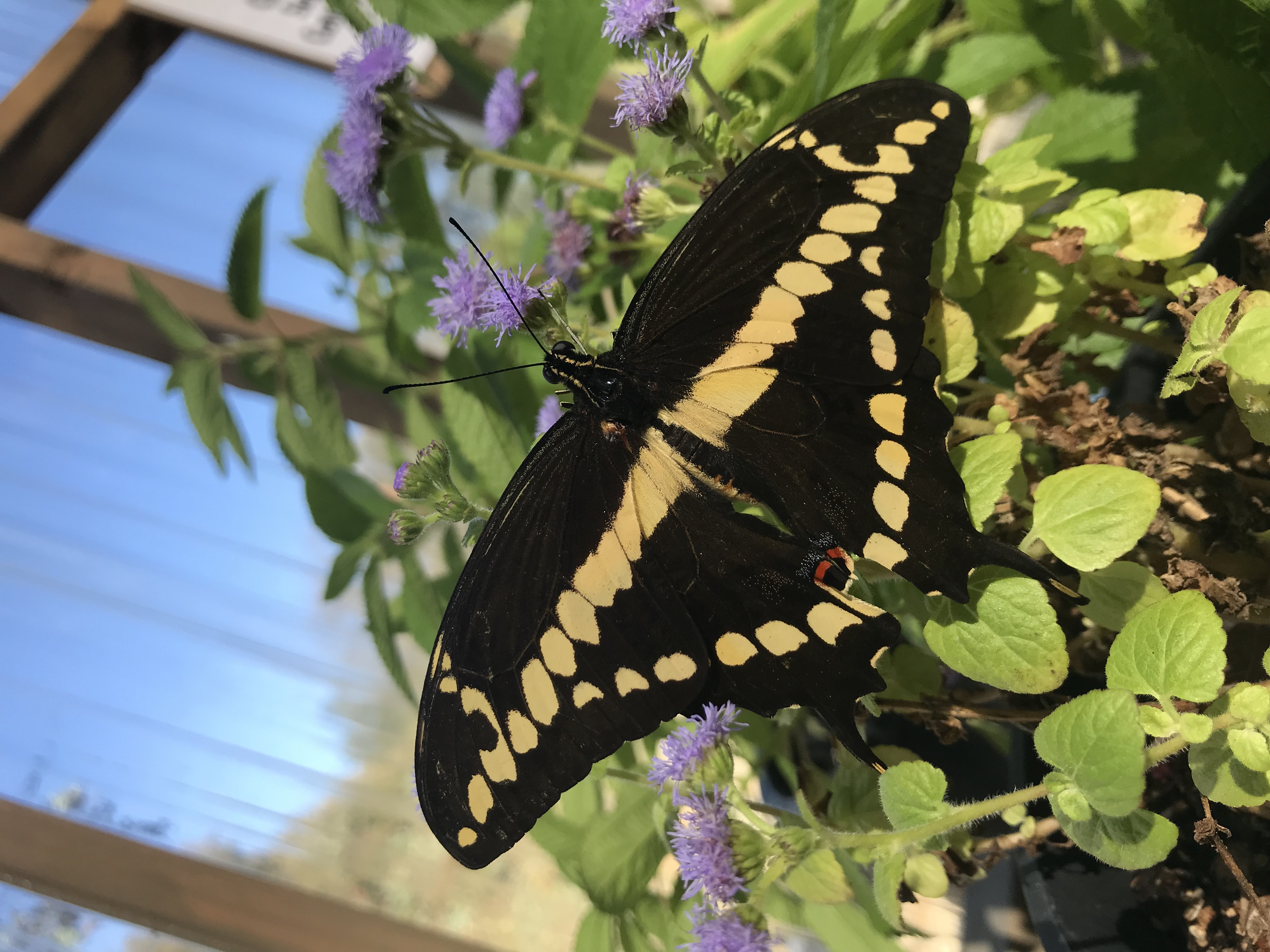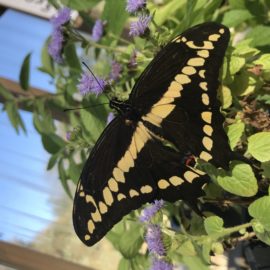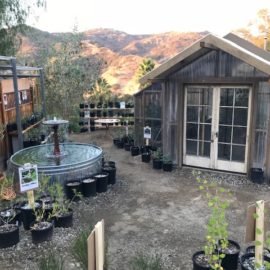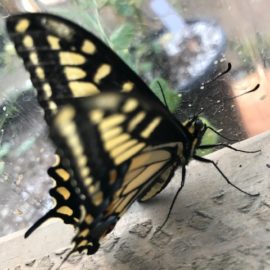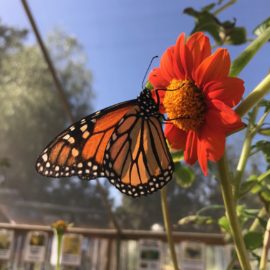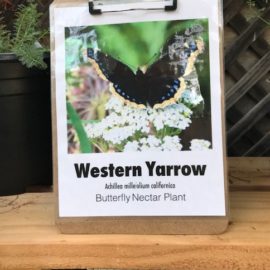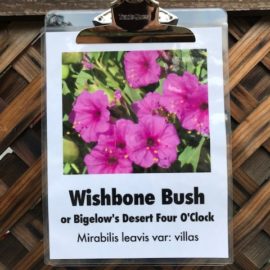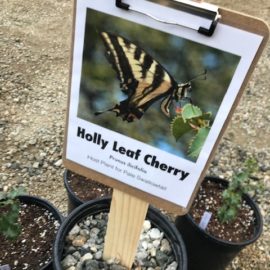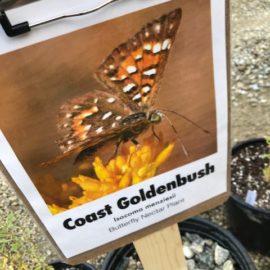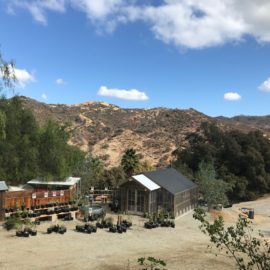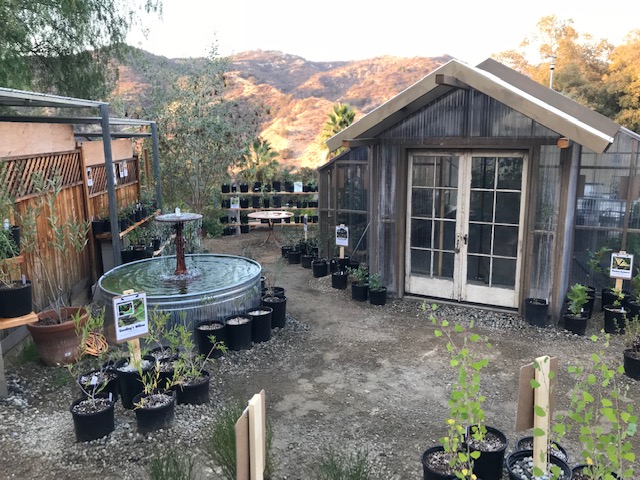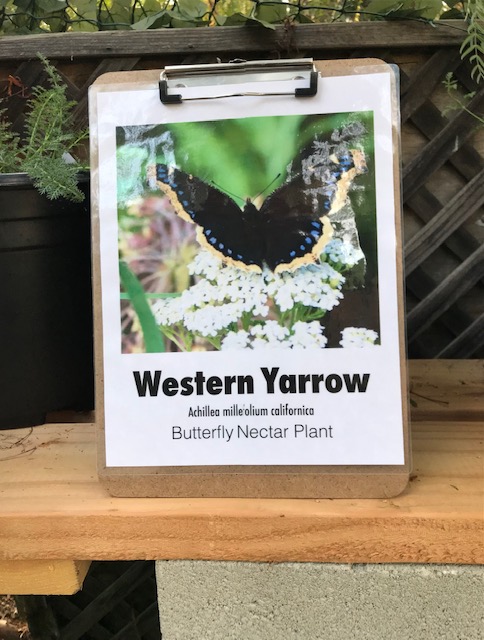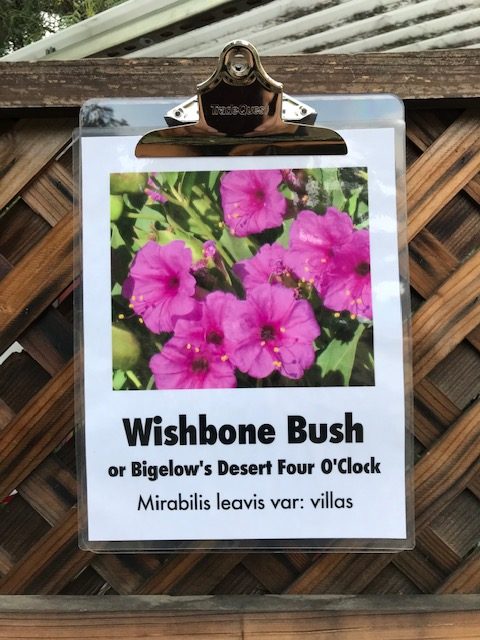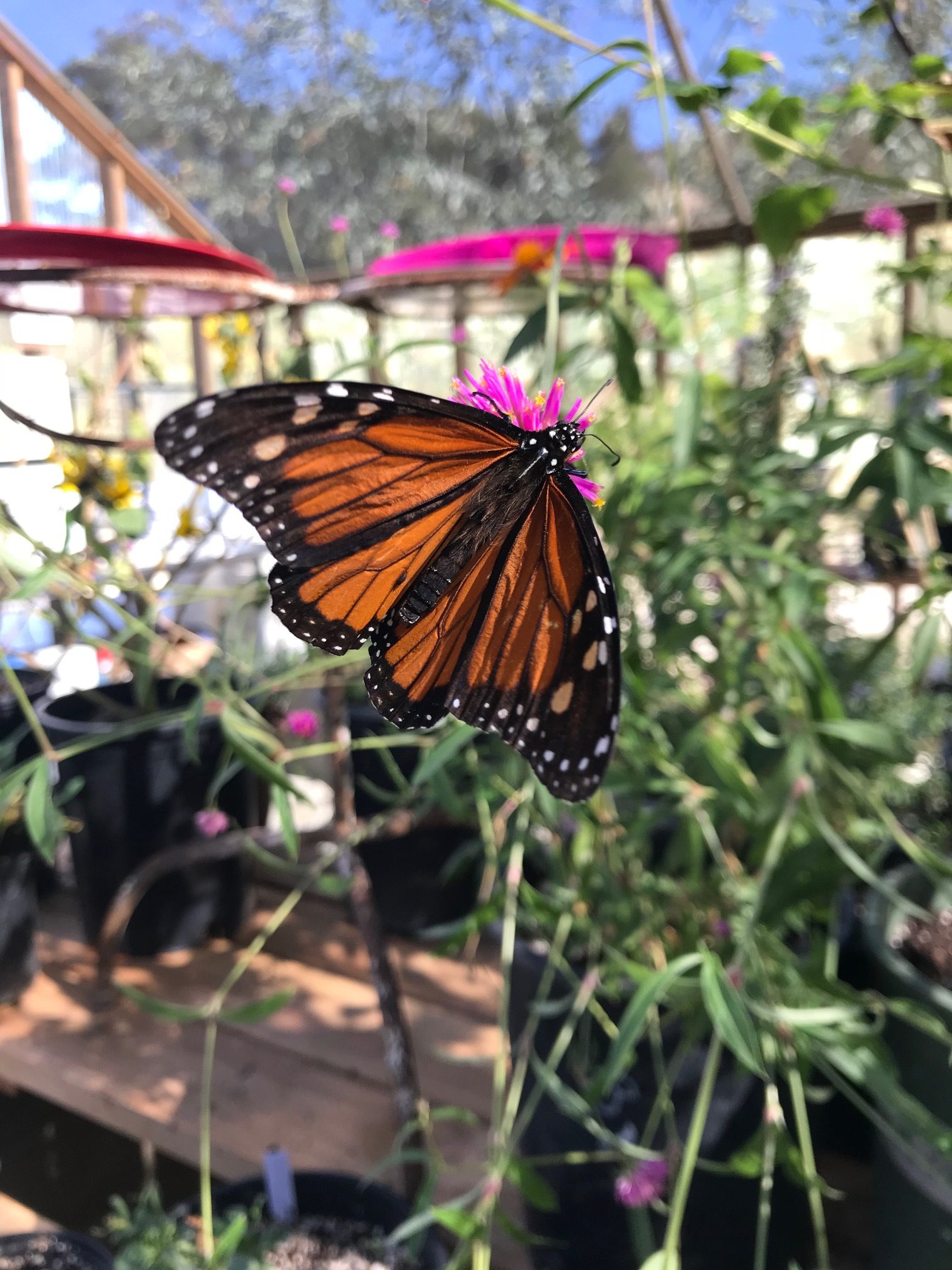Mountain Mermaid has a butterfly conservatory dedicated to the breeding and display of butterflies with an emphasis on education.
On Sunday, October 7, blessed with perfect weather, visitors floated from place to place around the Mermaid all day long, not unlike the creatures they came to see. The focus of the gathering was the unveiling of our new butterfly house.
A butterfly house—also called a butterfly conservatory, flight house, or lepidopterarium—is described in Wikipedia as a facility specifically intended for the breeding and display of butterflies with an emphasis on education.
I wanted to create a place of beauty and learning, but also a safe haven where we could breed butterflies in a predator-free environment. Only about 1.5 percent of butterflies live to the end of their complex four-stage life cycle alive. Most butterfly eggs we observe at the Mermaid are eaten by ants and other insects. Frogs, lizards, and birds pick off butterflies in all their stages—as eggs, caterpillars, chrysalis, and as full-fledged winged adults. As hard as we tried to make our butterfly house predator-proof, a mouse managed to get in and got two butterflies, consuming only the bodies and leaving there wings behind.
Butterflies have four life stages and can be either eggs, caterpillars, chrysalises, or winged adults. Adult female butterflies will only lay their eggs on one or a few select plants called “host” plants, and these are the only plants their caterpillars will eat. Adult winged butterflies, however, will drink from the flowers of many kinds of plants and those are called butterfly “nectar” plants. Put simply, butterfly caterpillars eat the leaves and stems of host plants for food, while flying butterfly adults drink the nectar from the flowers of nectar plants for their food.
The wood-framed greenhouse-like structure has walls of clear polycarbonate plastic siding and a roof made of shade cloth. Located midlevel on the property, it is stocked with several dozen species of pesticide-free butterfly host and nectar plants and is surrounded outside by hundreds more plants available to purchase or puruse. The structure is about the size of a two-car garage but seems bigger and can easily accommodate 15 visitors at a time.
Inside, along the two longest sidewalls are host plants for a dozen species of butterflies, including milkweed for Monarchs, horseradish for Cabbage Whites, mallows for Painted Ladies, grasses for Skippers, Passion Vines for Gulf Fritillaries, and California Pipevines for Pipevine Swallowtails. Nectar plants are in the middle of the building, and at the far end are tables displaying various species of live butterfly caterpillars and chrysalises.
Colorful graphic signage was installed throughout the Mermaid grounds and butterfly house with lots of pictures of butterflies and butterfly plants with names and explanations.
For the event, the butterfly house contained about 150 butterflies, including 100 or so Painted Ladies, a dozen Monarchs, ten Anise Swallowtails, half a dozen Gulf Fritillaries, a couple of Duskywings, and some Skippers. It was just the right amount to create a substantial butterfly experience.
Typically, most plants are planted in the ground at butterfly houses. What sets our modest house apart is that all the plants are contained and displayed in pots inside and outside around the structure. It’s more akin to a nursery in this regard. Also, we encourage butterflies to breed inside which most other butterfly houses do not.
Most of our plants were displayed on shelves, a design inspired and built by Sergio Jimenez, the Mermaid’s resident butterfly whisperer. Sergio and his wife, Yaotl, and three daughters assisted with sales and dispensing information at the event. Yaotl created a helpful full-color flip book illustrating local butterflies and their host plants.
Malibu resident, Anita Gnan, was in the Mermaid’s great room featuring her children’s book, “Kibble: The Monarch Caterpillar Afraid to Get Wings.” Representatives from Topanga State Park Docents, Topanga Creek Watershed Committee, Topanga Elementary Science Committee, and the Malibu Monarch Project were at tables around the pool. Face painter Natalie Davis and others created butterfly faces. Topanga songbird Donna De Lory and children from Topanga schools sang butterfly-themed songs that Donna had written.
Fifty years ago butterfly houses were virtually nonexistent. Today, there are hundreds of butterfly facilities scattered all around the world located on every continent. Many have birds, frogs and other wildlife as well.
Locally, there is a “Butterfly Pavilion” at Los Angeles Museum of Natural History, with hundreds of butterflies, and “Butterflies Alive” in Santa Barbara containing 1,000 Butterflies. There is a $25 million mega-facility now under construction in Buena Park called Butterfly Palladium that will have thousands of butterflies. There are butterfly houses in Claremont and Newport Beach as well.
So, what’s with the proliferation of all these butterfly houses? My theory is that humans are living in a increasingly unnatural and processed word and long, if subconsciously, for the natural world out of which they evolved. Lush butterfly houses rife with foliage and butterflies are reminiscent of a time when humans were more embedded in nature.
Monarch populations are crashing—there are 80-90 percent fewer Monarchs inhabiting our airspace than there was just 20 years ago. Species are increasingly going extinct, and insect, butterfly and bird counts are down all over the world. I am saddened by the loss of butterflies that used to fly the skies in the Santa Monica Mountains of my youth.
The mission of the Mermaid Butterfly House is to celebrate, educate, and help to preserve native butterfly and plant species, to heighten pollinator awareness, to give butterflies a leg up and make it easier to buy pesticide-free native butterfly plants, and to create sustainable eco-systems in our gardens filled with birdsong, frog choruses, and wafting butterflies.
For native butterfly plants, call Sergio or Yaotl Jimenez at (310) 455-7191, or email them at yaotl1217@gmail.com.
By Bill Buerge

